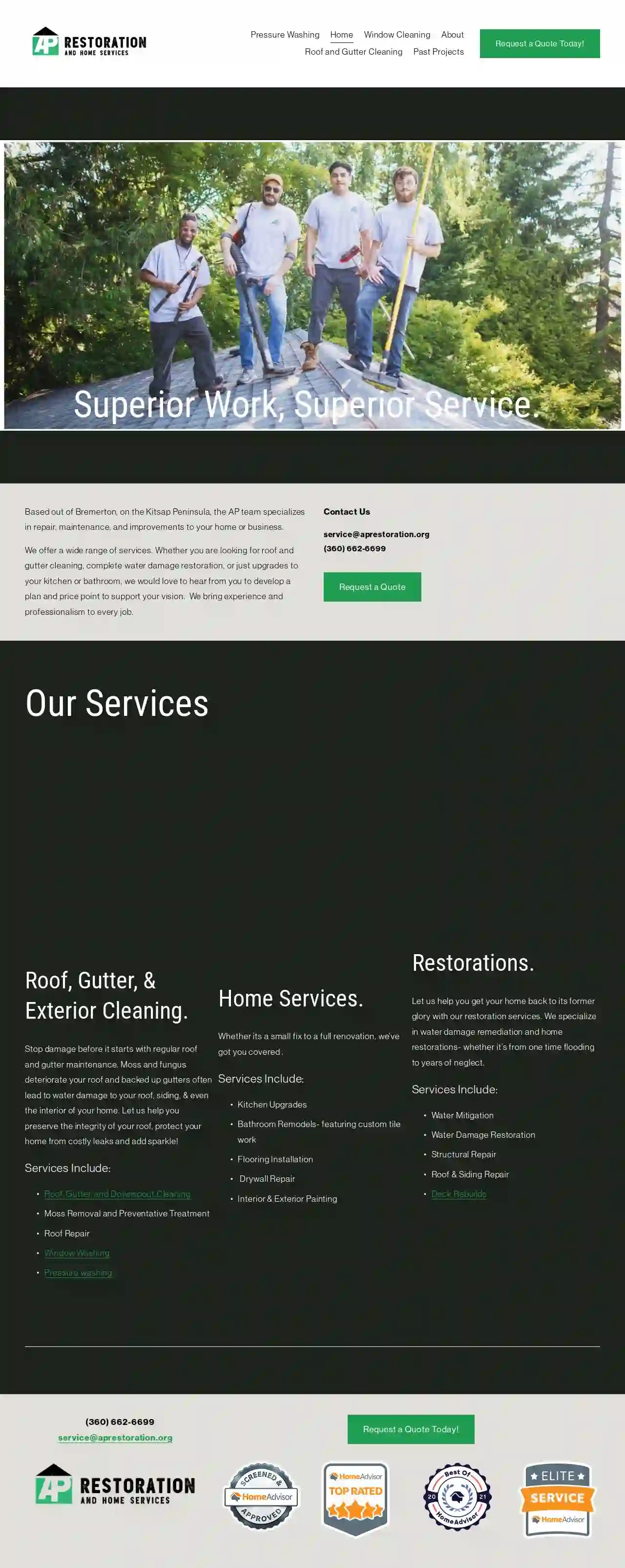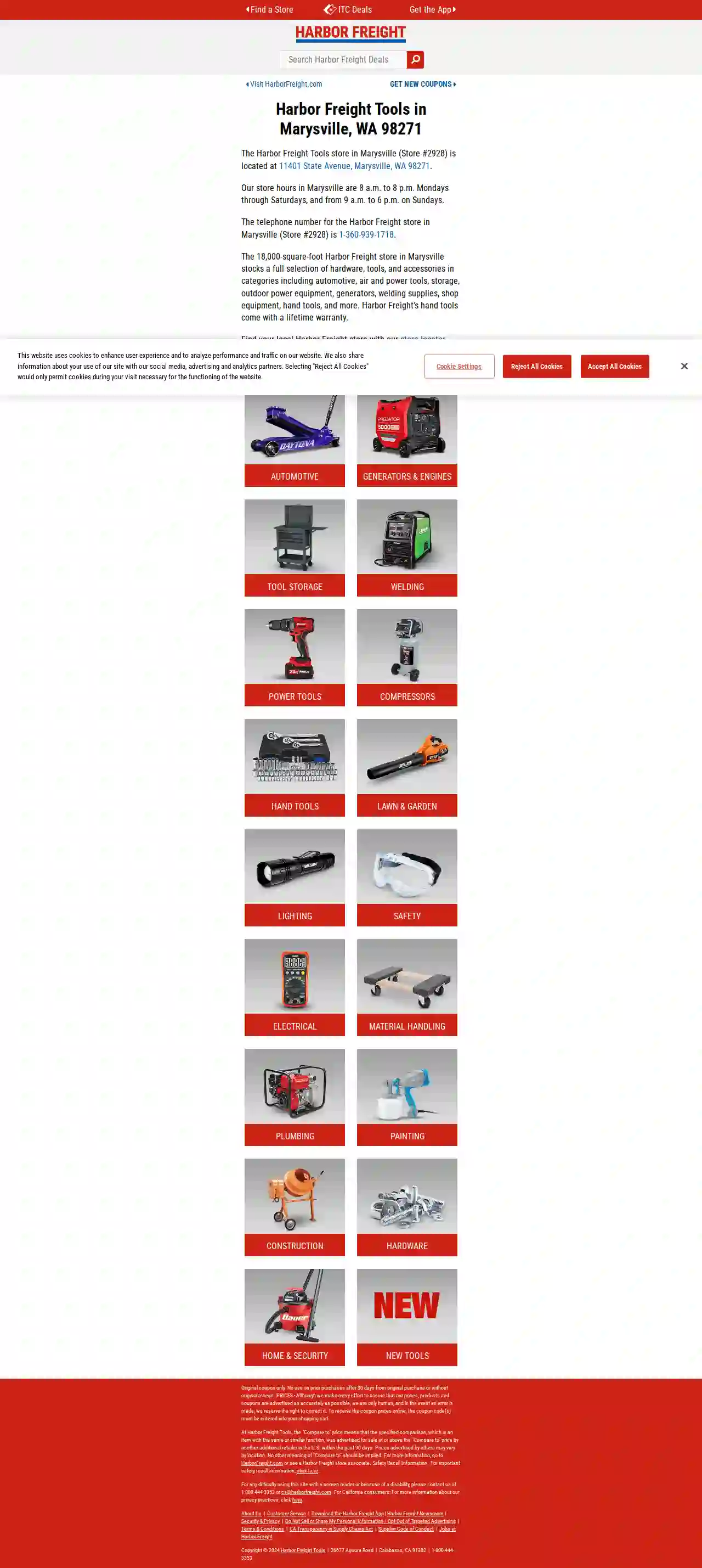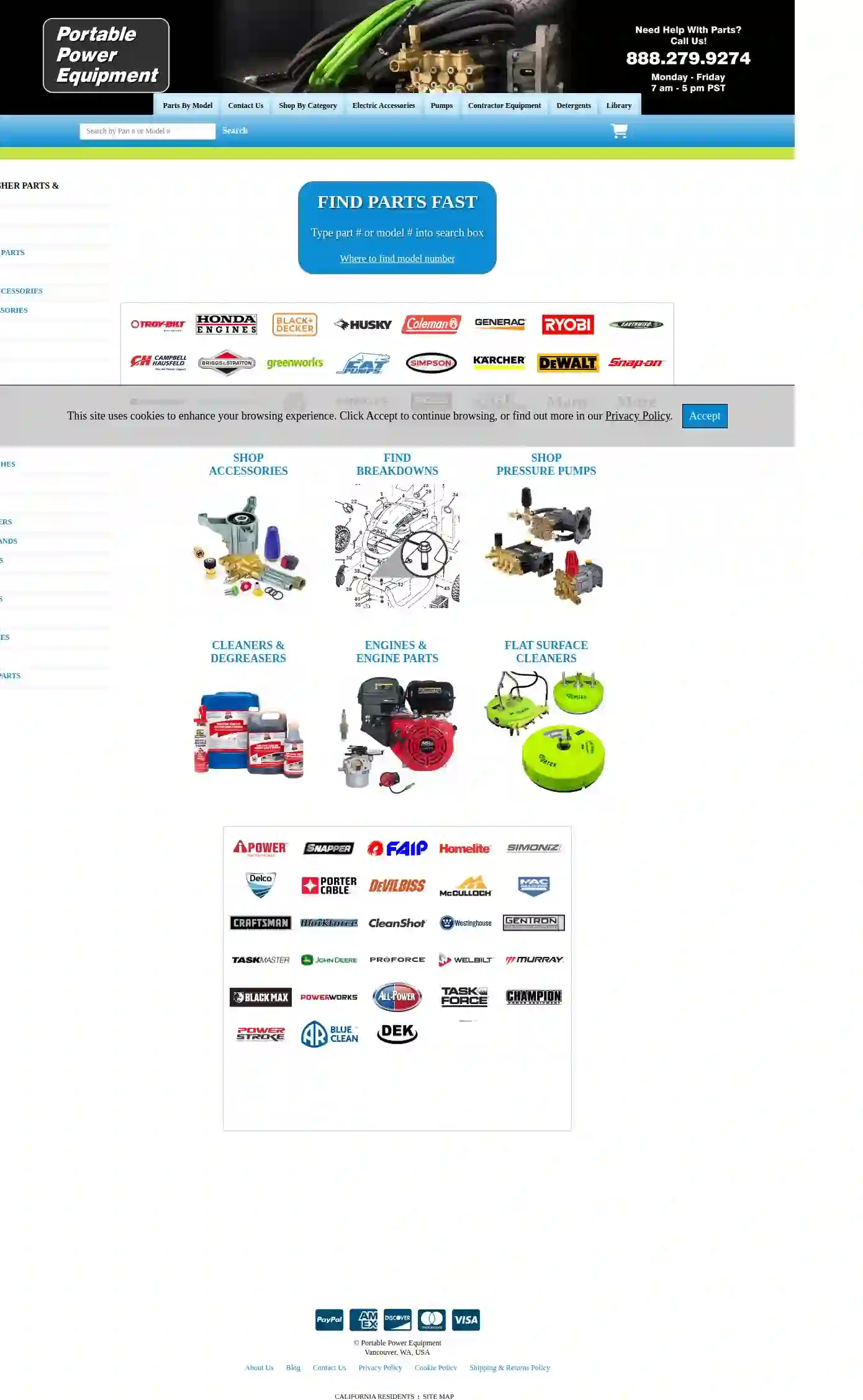Pressure Washing Longview
Find top Deck and Fence Cleaning in Longview
Receive multiple Exterior Cleaning quotes for your project today! Compare profiles, reviews, accreditations, portfolio, etc... and choose the best deal.

Quality Control Pressure Washing Services
54 reviewsBurnaby, V5C2Z9, USQuality Control Pressure Washing Services is a Vancouver-based pressure washing company dedicated to providing top-notch customer service and exceptional results for both residential and commercial properties. We are committed to transforming your exterior surfaces from dull and faded to stunningly clean. Our team of skilled and experienced professionals offers a wide range of pressure washing services tailored to meet your specific needs. Whether you need brick cleaning, building washing, deck cleaning, driveway washing, fence cleaning, gutter cleaning, house washing, organic growth removal, parking lot cleaning, paver cleaning, pool deck cleaning, roof washing, sidewalk washing, storefront cleaning, stucco cleaning, or vinyl siding cleaning, we have the expertise and equipment to deliver outstanding results. We proudly serve Vancouver and the surrounding areas, including West Vancouver, Burnaby, Delta, Richmond, Surrey, White Rock, Langley, Coquitlam, and Tsawwassen.
- Services
- Why Us?
- Accreditations
- Gallery
Get Quote
AP Restoration and Home Services
53 reviewsBremerton, USSuperior Work, Superior Service. Based out of Bremerton, on the Kitsap Peninsula, the AP team specializes in repair, maintenance, and improvements to your home or business. We offer a wide range of services. Whether you are looking for roof and gutter cleaning, complete water damage restoration, or just upgrades to your kitchen or bathroom, we would love to hear from you to develop a plan and price point to support your vision. We bring experience and professionalism to every job. Contact Us [email protected] (360) 662-6699 Request a Quote Our Services Roof, Gutter, & Exterior Cleaning. Stop damage before it starts with regular roof and gutter maintenance. Moss and fungus deteriorate your roof and backed up gutters often lead to water damage to your roof, siding, & even the interior of your home. Let us help you preserve the integrity of your roof, protect your home from costly leaks and add sparkle! Services Include: Roof, Gutter, and Downspout Cleaning Moss Removal and Preventative Treatment Roof Repair Window Washing Pressure washing Home Services. Whether its a small fix to a full renovation, we’ve got you covered . Services Include: Kitchen Upgrades Bathroom Remodels- featuring custom tile work Flooring Installation Drywall Repair Interior & Exterior Painting Restorations. Let us help you get your home back to its former glory with our restoration services. We specialize in water damage remediation and home restorations- whether it’s from one time flooding to years of neglect. Services Include: Water Mitigation Water Damage Restoration Structural Repair Roof & Siding Repair Deck Rebuilds
- Services
- Why Us?
- Gallery
Get Quote
Pressure Washing Pros
548 reviews107 Rabbit Run Road, Georgetown, 40324, USPressure Washing Pros is a family-owned company serving Lexington, KY and surrounding areas. We specialize in both residential and commercial pressure washing, offering a range of services from house and roof cleaning to playground and storefront washing. Our team is dedicated to providing high-quality service and using environmentally safe detergents whenever possible. We pride ourselves on our years of experience and commitment to customer satisfaction. If you need the best pressure washing in Lexington, contact us today for a free quote!
- Services
- Why Us?
- Accreditations
- Our Team
- Testimonials
- Gallery
Get Quote
Mountain View Pressure Washing And Softwash
518 reviews10000 NE 139th St, Vancouver, WA, 98661, USMountain View Pressure Washing and Softwash provides residential and commercial soft washing throughout Vancouver, WA and the surrounding areas. We’re dedicated to providing you with 100% satisfaction. Our processes will safely clean exteriors, roofs, decks, patios, driveways, sidewalks, windows, gutters, and more!
- Services
- Why Us?
- Our Team
- Testimonials
- Gallery
Get Quote
Surface Soakers Pressure Washing
512 reviews123 Main St, Suite 101, Bellevue, 98052, USSurface Soakers is a Commercial and Residential pressure washing company serving the greater eastside of Seattle WA. Professional hot water cleaning you can trust. At Surface Soakers, we help you preserve curb appeal, protect pavement, and maintain property value no matter the application to your home or business.
- Services
- Why Us?
- Accreditations
- Our Team
- Testimonials
- Gallery
Get Quote
Patriot Pressure Washing
4.9102 reviewsKent, USPatriot Pressure Washing and Exterior Cleaning is your trusted partner for all your residential and commercial exterior cleaning needs in Northern Kentucky and surrounding areas. We pride ourselves on providing safe, effective, and environmentally friendly cleaning solutions using our extensive knowledge of chemical application and hot water capabilities. Our team of experienced professionals is dedicated to restoring the beauty and curb appeal of your property. Whether you need a simple driveway cleaning or a complete house washing, we have the expertise and equipment to get the job done right. We offer a wide range of services, including soft washing, concrete cleaning, deck and fence washing, gutter cleaning, paver restoration, and rust removal. We also specialize in commercial exterior cleaning, such as building washing, parking lot cleaning, and graffiti removal. At Patriot Pressure Washing, we understand that your time is valuable. That's why we offer free and easy estimates. We use satellite imagery to take measurements and our pricing is based on the square footage. We'll get back to you within 24 hours with a competitive quote. Contact us today to schedule your free estimate and experience the Patriot Pressure Washing difference!
- Services
- Why Us?
- Our Team
- Testimonials
- Gallery
Get Quote
Drew's Pressure Washing Services
533 reviews140 King Fisher Way, Midway, 40347, USAt Drew's Pressure Washing Services, we take pride in being your top-rated pressure washing company in Lexington. With a commitment to excellence and a dedication to customer satisfaction, we have established ourselves as leaders in the industry, delivering exceptional results with every project. As a premier pressure washing company serving the Lexington area, we specialize in a wide range of services to meet your property's needs. From residential to commercial properties, we offer professional pressure washing solutions that enhance the appearance and longevity of your surfaces. Our team of experienced technicians is equipped with the latest tools and technology to tackle any pressure washing job with precision and efficiency. Whether you need a thorough roof cleaning to remove dirt and debris or a comprehensive pressure washing service to rejuvenate your home's exterior, we have the expertise to deliver outstanding results. When you choose Drew's Pressure Washing Services, you can trust that your property is in good hands. We understand the unique cleaning challenges faced by Lexington residents and businesses, and we tailor our services to meet your specific needs. From soft washing delicate surfaces to high-pressure cleaning tough stains, we have the skills and knowledge to get the job done right the first time. With our commitment to quality and customer satisfaction, we strive to exceed your expectations with every pressure washing project. Whether you're looking to boost your property's curb appeal or maintain its pristine condition, you can rely on Drew's Pressure Washing Services to deliver exceptional results that stand the test of time.
- Services
- Why Us?
- Accreditations
- Our Team
- Testimonials
- Gallery
Get Quote
Matt's Home Services
5244 reviewsVancouver, USLet Us Do It is a professional exterior cleaning and maintenance company dedicated to providing top-rated services for both residential and commercial properties. We take pride in our four core values: time-saving, equipped & safe, experienced, and friendly & reliable. Our team utilizes the latest cleaning equipment and products, ensuring a thorough and efficient service while prioritizing safety. With years of experience in the industry, we are committed to delivering exceptional results and exceeding customer expectations. We offer a wide range of services, including pressure washing, roof cleaning, soft washing, window cleaning, gutter cleaning, Christmas light installation, and snow removal. We understand that your property is an investment, and we strive to give it the care it deserves. Whether you need a simple refresh or a complete transformation, Let Us Do It is your trusted partner for all your exterior cleaning needs.
- Services
- Why Us?
- Gallery
Get Quote
Harbor Freight Tools
4.4970 reviews11401 State Avenue, Marysville, WA 98271, 98271, USHarbor Freight Tools in Marysville, WA 98271 is located at 11401 State Avenue, Marysville, WA 98271. The store hours are 8 a.m. to 8 p.m. Mondays through Saturdays, and from 9 a.m. to 6 p.m. on Sundays. The telephone number for the Harbor Freight store in Marysville (Store #2928) is 1-360-939-1718. The 18,000-square-foot Harbor Freight store in Marysville stocks a full selection of hardware, tools, and accessories in categories including automotive, air and power tools, storage, outdoor power equipment, generators, welding supplies, shop equipment, hand tools, and more. Harbor Freight’s hand tools come with a lifetime warranty.
- Services
- Why Us?
- Accreditations
- Our Team
- Testimonials
- Gallery
Get Quote
APW Distributing Inc.
3.450 reviews2310 E. 2nd St Suite A, Vancouver, 98661, USSince 1986, APW Distributing has specialized in all aspects of Pressure Washers. From application to repair, our team is available to you every step of the way. If you are looking for a specific part, need a repair or service, or just have general questions, APW Distributing can help. With 80 years of combined industry knowledge, we can help with part selection, repair tips, and installation instructions over the phone. If in-person is more your style, our showroom in Vancouver, Washington is stocked with parts, pressure washers, and demonstrations, so you can have answers and help instantly. Our competitive pricing and specialization sets us above and apart from big box stores. Come in today to see how APW Distributing does pressure washers, BETTER.
- Services
- Why Us?
- Accreditations
- Gallery
Get Quote
Over 60,241+ Cleaning Services registered
Our cleaning service providers operate in Longview and surrounding areas!
CleaningMatch has curated and vetted the Best Cleaning Contractors arround Longview. Find the most trustworthy contractor today.
Frequently Asked Questions About Pressure Washing
- Degreaser: For optimal results, pre-treat the oil stains with a degreaser specifically designed for driveways. Allow the degreaser to sit for the recommended time before pressure washing.
- Hot Water: Using hot water in your pressure washer can be more effective at breaking down oil than cold water.
- Surface Cleaner: Using a surface cleaner attachment for your pressure washer can provide a more even and efficient cleaning result.
- Electric Pressure Washers: Suitable for light-duty cleaning tasks like washing cars, patios, or fences. They are less powerful than gas pressure washers but are generally more affordable and easier to operate.
- Gas Pressure Washers: More powerful than electric pressure washers, making them suitable for heavier cleaning tasks like removing stubborn stains, cleaning driveways, or stripping paint.
- PSI and GPM: Consider the PSI (Pounds per Square Inch) and GPM (Gallons per Minute) ratings. Higher PSI and GPM indicate a more powerful pressure washer. For most home cleaning tasks, a pressure washer with a PSI of 2000-3000 and a GPM of 2-3 is sufficient.
- Soft Washing: Soft washing is generally recommended for wood decks as it uses lower pressure and specialized cleaning solutions to safely remove dirt, mildew, and algae without causing damage.
- Lower Pressure Setting: If using a pressure washer on a wood deck, use a lower pressure setting (around 1500 PSI) and a wide-angle nozzle (25-40 degrees).
- Maintain Distance: Hold the nozzle at least 12 inches away from the deck surface to prevent etching or splintering.
- Professional Pressure Washing: If you're unsure about pressure washing your deck safely, hire a professional pressure washing company with experience in cleaning wood surfaces.
- Size of the Area: Larger areas generally cost more to pressure wash than smaller ones.
- Type of Surface: Different surfaces require different pressure levels and cleaning solutions, which can affect pricing.
- Condition of the Surface: Heavily soiled or stained surfaces may require more time and effort to clean, impacting cost.
- Accessibility: Difficult-to-reach areas may require specialized equipment and increase costs.
- Additional Services: Services like pre-treating stains, applying protective coatings, or mold removal may incur additional charges.
Can pressure washing remove oil stains from my driveway?
If DIY pressure washing doesn't completely remove the oil stains, consider hiring a professional pressure washing company. They have specialized equipment and experience in dealing with stubborn stains.
What type of pressure washer do I need for my home?
If you're unsure about the type of pressure washer best suited for your needs, consult with a pressure washing professional or a home improvement specialist.
Can pressure washing damage my deck?
By using the right cleaning method and precautions, you can effectively clean your wood deck without causing damage and prolong its lifespan.
How much does pressure washing cost?
To get accurate pricing, request quotes from multiple pressure washing companies. Provide details about the size and type of surface, its condition, and any additional services you require.
Can pressure washing remove oil stains from my driveway?
- Degreaser: For optimal results, pre-treat the oil stains with a degreaser specifically designed for driveways. Allow the degreaser to sit for the recommended time before pressure washing.
- Hot Water: Using hot water in your pressure washer can be more effective at breaking down oil than cold water.
- Surface Cleaner: Using a surface cleaner attachment for your pressure washer can provide a more even and efficient cleaning result.
If DIY pressure washing doesn't completely remove the oil stains, consider hiring a professional pressure washing company. They have specialized equipment and experience in dealing with stubborn stains.
What type of pressure washer do I need for my home?
- Electric Pressure Washers: Suitable for light-duty cleaning tasks like washing cars, patios, or fences. They are less powerful than gas pressure washers but are generally more affordable and easier to operate.
- Gas Pressure Washers: More powerful than electric pressure washers, making them suitable for heavier cleaning tasks like removing stubborn stains, cleaning driveways, or stripping paint.
- PSI and GPM: Consider the PSI (Pounds per Square Inch) and GPM (Gallons per Minute) ratings. Higher PSI and GPM indicate a more powerful pressure washer. For most home cleaning tasks, a pressure washer with a PSI of 2000-3000 and a GPM of 2-3 is sufficient.
If you're unsure about the type of pressure washer best suited for your needs, consult with a pressure washing professional or a home improvement specialist.
Can pressure washing damage my deck?
- Soft Washing: Soft washing is generally recommended for wood decks as it uses lower pressure and specialized cleaning solutions to safely remove dirt, mildew, and algae without causing damage.
- Lower Pressure Setting: If using a pressure washer on a wood deck, use a lower pressure setting (around 1500 PSI) and a wide-angle nozzle (25-40 degrees).
- Maintain Distance: Hold the nozzle at least 12 inches away from the deck surface to prevent etching or splintering.
- Professional Pressure Washing: If you're unsure about pressure washing your deck safely, hire a professional pressure washing company with experience in cleaning wood surfaces.
By using the right cleaning method and precautions, you can effectively clean your wood deck without causing damage and prolong its lifespan.
How much does pressure washing cost?
- Size of the Area: Larger areas generally cost more to pressure wash than smaller ones.
- Type of Surface: Different surfaces require different pressure levels and cleaning solutions, which can affect pricing.
- Condition of the Surface: Heavily soiled or stained surfaces may require more time and effort to clean, impacting cost.
- Accessibility: Difficult-to-reach areas may require specialized equipment and increase costs.
- Additional Services: Services like pre-treating stains, applying protective coatings, or mold removal may incur additional charges.
To get accurate pricing, request quotes from multiple pressure washing companies. Provide details about the size and type of surface, its condition, and any additional services you require.